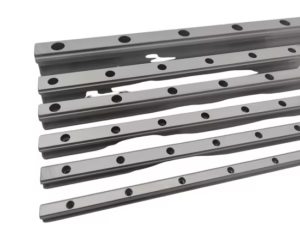Outline for Linear Rail Reach Article
| Heading | Sub-Headings |
|---|---|
| Introduction | Definition of linear rail reach, importance in engineering |
| Linear Rail Reach | What is reach in linear systems, basic explanation |
| Importance of Reach in Linear Systems | Why engineers care about reach, impact on performance |
| Components That Influence Reach | Rails, carriages, bearings, and support structures |
| Standard Reach vs. Extended Reach | Differences between typical and long-travel systems |
| Telescopic Reach in Linear Rails | Concept of telescoping motion |
| Design Considerations for Reach | Load, deflection, and alignment factors |
| Material Impact on Reach | Stainless steel vs. carbon steel vs. composites |
| Factors Affecting Accuracy Over Reach | Friction, vibration, and tolerance issues |
| Load Capacity vs. Reach | Balancing length and weight support |
| Linear Rail Reach in CNC Machines | Applications in manufacturing |
| Linear Rail Reach in Robotics | Extended movements for automation |
| Linear Rail Reach in Medical Devices | Precision applications in healthcare |
| Gantry Systems and Long Reach Rails | Large-scale applications |
| Maintenance Needs for Long Reach Systems | Lubrication, cleaning, and inspection |
| Challenges with Extended Reach | Deflection, misalignment, and wear |
| Solutions for Extending Reach | Dual rails, stiffening frames, telescopic designs |
| Advantages of Long Reach Rails | Benefits in automation and industry |
| Limitations of Long Reach Rails | Trade-offs in design |
| Safety in Long Travel Systems | Stops, dampers, and sensors |
| Future of Linear Rail Reach | Smart rails, AI integration, predictive maintenance |
| Case Studies of Linear Rail Reach | Real-world industrial examples |
| Environmental Impact of Long Rails | Energy efficiency and sustainability |
| Cost Considerations for Extended Reach | Budget vs. performance |
| Choosing the Right Reach | Guidelines for engineers and buyers |
| FAQs | Common questions and expert answers |
| Conclusion | Wrap-up of linear rail reach benefits |
Introduction
In modern engineering, motion systems form the backbone of countless industries. From robotics to medical devices, from CNC machining to aerospace, precision matters more than ever. At the heart of these systems lies a key factor that often goes unnoticed but determines performance—linear rail reach. Understanding reach not only helps engineers design better machines but also ensures accuracy, longevity, and safety in critical applications.
Linear Rail Reach
Linear rail reach refers to the maximum distance or travel length a carriage can move along a rail. It defines how far a load or tool can be positioned or transported within a mechanical system. Unlike simple sliding mechanisms, linear guide rails allow smooth, low-friction motion across long distances, making reach a central consideration in system design.

Importance of Reach in Linear Systems
Why does reach matter so much? For one, it directly influences how far a machine can perform work—whether cutting, assembling, or inspecting. Too short a reach limits functionality, while excessive reach without proper design introduces instability. Reach determines:
Workspace Size – How much area a tool can cover.
Precision Control – Longer reach challenges stability but enables broader tasks.
System Efficiency – Correct reach reduces unnecessary motion or redesigns.
Components That Influence Reach
Several elements dictate the practical reach of a linear rail:
Rail Length – The most obvious factor; longer rails allow longer reach.
Carriage Size – Larger carriages may support greater reach but add weight.
Bearings – Ball vs. roller bearings affect smoothness and load tolerance.
Support Structure – Weak bases shorten effective reach due to deflection.
Standard Reach vs. Extended Reach
Standard Reach: Limited by the physical rail length. Common in compact CNC machines.
Extended Reach: Achieved by telescoping or linking multiple rails. Found in automation and robotics where longer travel is essential.
Telescopic Reach in Linear Rails
Telescopic rails extend beyond their physical length by sliding nested sections. This design allows a compact system to achieve extended travel without requiring oversized rails. Common examples include industrial drawers, medical scanning beds, and robotic transfer systems.
Design Considerations for Reach
When engineering for reach, several design parameters come into play:
Load Distribution – The longer the reach, the greater the torque forces.
Rigidity – Rails must resist bending over extended lengths.
Alignment – Precision drops quickly if alignment shifts across long travel.
Vibration Control – Long rails amplify oscillations, impacting accuracy.
Material Impact on Reach
Material choice has a huge impact:
Stainless Steel – Corrosion-resistant, ideal for clean environments.
Carbon Steel – High rigidity, excellent for heavy-duty extended reach.
Composites and Alloys – Lightweight, used in aerospace and robotics for long but precise strokes.
Factors Affecting Accuracy Over Reach
As reach increases, challenges grow:
Friction Build-up – More travel = more surface interaction.
Thermal Expansion – Rails may expand or contract, affecting precision.
Tolerance Drift – Even minor misalignments compound across long reaches.
Load Capacity vs. Reach
Longer reach often reduces load capacity unless compensated by stronger designs. Engineers must calculate:
Static load (resting weight).
Dynamic load (moving weight).
Moment loads (twisting forces).
Balancing these factors ensures stability over long travel.
Linear Rail Reach in CNC Machines
CNC machines require rails that support heavy spindles and workpieces across long reaches. Extended reach enables machining of larger parts while maintaining micrometer-level accuracy. Without proper reach, manufacturing large molds or aerospace components would be impossible.
Linear Rail Reach in Robotics
Robotic systems rely on reach for flexibility. Whether assembling products or managing logistics, longer reach rails allow robots to cover greater areas without needing repositioning. In collaborative robots, reach enables extended work zones while preserving safety.
Linear Rail Reach in Medical Devices
Medical imaging machines like MRI and CT scanners depend on rails with long reach to move beds smoothly. Surgical robots also use extended reach for precise yet broad motion ranges. Accuracy here isn’t just about efficiency—it’s about patient safety.
Gantry Systems and Long Reach Rails
Large gantry systems, such as those in aerospace manufacturing, use rails spanning several meters. Long reach ensures coverage of massive parts without sacrificing speed or accuracy. Gantries often rely on dual-rail setups for stability.
Maintenance Needs for Long Reach Systems
Extended reach systems demand stricter maintenance:
Lubrication – Prevents friction buildup.
Cleaning – Dust and debris accumulate more easily over long rails.
Inspection – Checking for alignment issues or wear.
Challenges with Extended Reach
Deflection – Rails may bend under load.
Noise – Longer rails amplify vibrations.
Wear – Greater travel accelerates bearing fatigue.
Solutions for Extending Reach
Dual Rail Systems – Reduce deflection and improve load support.
Stiffening Frames – Strengthen the base for longer rails.
Telescopic Designs – Compact yet extendable.
Advantages of Long Reach Rails
Greater work coverage.
Higher productivity.
Versatility across industries.
Limitations of Long Reach Rails
Higher costs.
More maintenance.
Sensitivity to misalignment.
Safety in Long Travel Systems
To avoid overtravel or damage:
End Stops – Prevent carriages from sliding off.
Dampers – Reduce shock at the end of travel.
Sensors – Detect over-extension.
Future of Linear Rail Reach
Innovations include:
Smart Rails – Built-in sensors for predictive maintenance.
AI Optimization – Self-adjusting reach and loads.
Nano-Coatings – For smoother long travel and longer lifespan.
Case Studies of Linear Rail Reach
Automotive Industry: Extended reach rails assemble car frames with precision.
Aerospace: Long rails handle giant fuselage sections.
Semiconductors: Long travel enables scanning wafers at nano-level accuracy.
Environmental Impact of Long Rails
Extended rails help reduce waste and energy use by enabling automation and reducing downtime. Longer service life also lowers material consumption.
Cost Considerations for Extended Reach
Extended reach rails cost more, but they return value by:
Increasing productivity.
Reducing downtime.
Extending machine versatility.
Choosing the Right Reach
To select the best reach:
Define the application requirements.
Balance load vs. length.
Consider environmental factors.
Evaluate long-term ROI.
FAQs
What is linear rail reach?
It is the maximum travel length a carriage can move along a linear rail.
Why is reach important in machines?
It defines how far tools or loads can move, directly affecting productivity.
Can linear rails have unlimited reach?
No, they are limited by material strength, load capacity, and alignment.
How do telescopic rails increase reach?
By using nested sections that extend beyond physical rail length.
Do longer rails require more maintenance?
Yes, extended reach systems need frequent lubrication and inspections.
Which industries need long reach rails?
CNC machining, robotics, aerospace, medical imaging, and packaging.
Conclusion
The linear rail reach plays a decisive role in the functionality of motion systems. Whether enabling a CNC machine to cut large parts, allowing a robot to cover more workspace, or supporting medical devices in patient care, reach defines capability. While extended reach introduces challenges like deflection and maintenance, innovations in materials, design, and smart technology are pushing the boundaries. For engineers, choosing the right reach is a balancing act between performance, precision, and durability.



